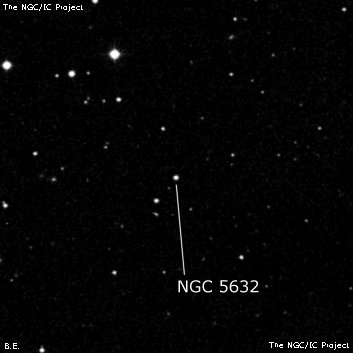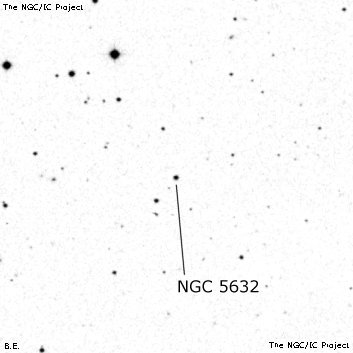NGC/IC Project Restoration Effort
(This is a very very beta version)
NGC5632


Basic Information
Location and Magnitude
Right Ascension: 14:37:53.4
Declination: -0:23:53
Constellation: VIR
Visual Magnitude: 11.8
Historic Information
Discoverer: Bond
Year of discovery: 1853
Discovery aperture: 15.0
Observational
Summary description: Neb, * 11 f 150s (Auw 33)
Sub-type: SBa/P
Corwin's Notes
=====
NGC 5632, NGC 5651, and NGC 5658 are nebulae found by Harvard College
Observatory's G.P. Bond. He found all three of these on the night of 9 May
1853, and his positions are close enough to stars that both Arthur Auwers and
I took the stars to be Bond's objects. Auwers, however, still described them
as nebulae. For NGC 5632, Auwers also noted an 11th magnitude star following
the nebula on the parallel by 2 minutes 30 seconds of time. That star is
GSC 4984-0094 at 14 31 49.66, -00 26 03.3 (n = 2, J2000.0), and is actually
included in the NGC description.
The three stars are at
SDSS Bond
(J2000) (J2000)
"NGC 5632" 14 29 19.55 -00 26 53.4 14 29 20 -00 26.3
"NGC 5651" 14 31 12.70 -00 19 22.7 14 31 10 -00 19.2
"NGC 5658" 14 31 55.29 -00 22 02.3 14 31 55 -00 22.0
It's easy to see why we were misled into thinking these were nothing more than
three stars.
In March of 2015, Yann Pothier raised an interesting possibility that Bond
actually observed three galaxies, NGC 5691, 5713, and 5719. Indeed, Bond's
descriptions of the last two of these, while scanty (NGC 5713 is called "A
round nebula", and NGC 5719 "An elongated nebula, fainter than the above";
NGC 5691 is simply "A nebula"), are still appropriate, especially the shape
and brightness of NGC 5719. Yann also suggested that the positions are off by
a simple offset in RA.
I looked into this, and assembled the following table of J2000 positions and
differences:
N5632 14 29 20.0 -00 26 23 Bond's position
N5632 14 29 19.55 -00 26 53.4 SDSS position for star
delta pos, *-Bond -0.45 +00 30.4
N5691 14 37 53.34 -00 23 56.0 SDSS position for galaxy
delta pos, G-Bond +08 33.34 +02 27
- - -
N5651 14 31 10.8 -00 19 09 Bond's position
N5651 14 31 12.70 -00 19 22.7 SDSS position for star
delta pos, *-Bond +1.90 -00 13.7
N5713 14 40 11.51 -00 17 20.3 SDSS position for galaxy
delta pos, G-Bond +09 00.71 +01 49
- - -
N5658 14 31 55.9 -00 22 03 Bond's position
N5658 14 31 55.29 -00 22 02.3 SDSS position for star
delta pos, *-Bond -0.61 -00 00.7
N5719 14 40 56.36 -00 19 05.5 SDSS position for galaxy
delta pos, G-Bond +09 00.46 +02 58
While I found it interesting that Bond's positions have much smaller internal
scatter assuming he measured the stars rather than the galaxies, this turned
out to be a simple coincidence. It was no coincidence, however, that he notes
all three objects "In Harvard Zones". This implies that he was doing
astrometric work that night, as indeed he was.
Wolfgang dug out the original publication of the nebulae in the Harvard
Annals, Volume 1, Part 2. They are mentioned on page 283 where they are
linked to star number 118 with the following note:
A round nebula precedes No. 118 39s, 7' North of it. A fainter elongated
nebula follows No. 118 6s, and is 4' North of it. Another nebula precedes
No. 118 2m 30s, and is in the same declination with star No. 118.
Wolfgang also found that if we substitute star 129 for 118, then the positions
of Bond's nebulae become (reduced using the 1853 position given by Bond for
star 129, then precessed to J2000):
NGC 5632 14 38 21 -00 24.0
NGC 5651 14 40 12 -00 16.8
NGC 5658 14 40 57 -00 19.7
These are close to the galaxies NGC 5691, 5713, and 5719; and Bond's scanty
descriptions noted above fit them well enough, especially the elongation of
NGC 5719 and its brightness relative to NGC 5713. There is no doubt that
these are the galaxies that Bond observed; he simply attached them to the
wrong star.
Steve's Notes
=====
NGC 5632
See observing notes for NGC 5691.



